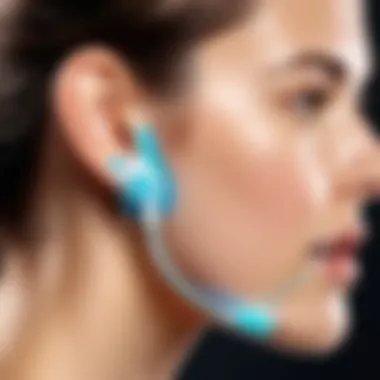Understanding Conductive Earbuds: Features and Benefits


Intro
Conductive earbuds represent a significant evolution in personal audio technology. They employ a distinct method called bone conduction to transmit sound, bypassing the eardrum entirely. This feature addresses many common limitations associated with traditional earbuds. As consumers become more aware of sound health and quality, conductive earbuds are gaining popularity. Their unique design caters to various needs and preferences, making them a compelling choice for a broad audience.
Overview of the Product
Purpose and Benefits
Conductive earbuds aim primarily to deliver audio through vibrations conducted via the bones of the skull. This technology allows for a more open ear experience, which can be advantageous for those who wish to remain aware of their surroundings. The benefits of this approach include:
- Hearing health: Reduced pressure on the eardrum minimizes damage risks associated with prolonged use of traditional earbuds.
- Comfort: Designed often to be lightweight and ergonomic, they typically provide a comfortable fit for long durations.
- Situational awareness: Users can enjoy music or podcasts while still hearing ambient sounds, making them suitable for outdoor activities such as cycling or jogging.
Target Audience
The audience for conductive earbuds is diverse. They appeal especially to:
- Fitness enthusiasts who prioritize safety while exercising outdoors.
- Professionals needing to multitask or communicate while wearing audio devices.
- Individuals with certain hearing impairments who may benefit more from bone conduction technology.
Key Features
Key features that distinguish conductive earbuds from others include:
- Bone conduction technology that allows sound to travel through the skull.
- Open ear design that lets the user hear external noises.
- Sweat and water resistance catering to athletic activities.
- Bluetooth connectivity for wireless convenience.
Technical Specifications
Detailed Product Specs
Understanding the technical elements of conductive earbuds enhances a user's ability to choose the best product for their needs. Typically, specifications include:
- Driver type: Dynamic drivers are common in these models to enhance sound quality.
- Frequency response: Most conductive earbuds operate within a range of 20 Hz to 20 kHz.
- Battery life: Average use usually ranges between 6-12 hours on a single charge.
Performance Benchmarks
Performance benchmarks indicate:
- Audio quality: Varies by product, but many models offer reasonably rich sound.
- Connection stability: Generally strong, with minimal lag during use.
Comparison with Similar Products
Market Competitors
In the market, conductive earbuds compete with traditional options from brands like AfterShokz and Bose. Each brand has unique strengths:
- AfterShokz: Known for a variety of models tailored to fitness activities.
- Bose: Offers high-quality sound but may not focus exclusively on bone conduction.
Comparative Analysis
When comparing conductive earbuds with traditional ones, one can observe:
- Health considerations: Traditional earbuds can lead to prolonged hearing issues; conductive options mitigate this.
- Sound isolation: Traditional models might excel in bass response but isolate external sounds.
Best Use Cases
Ideal scenarios for using conductive earbuds include:
- Running or cycling where awareness of surroundings is crucial.
- Office settings where multi-tasking is necessary alongside music enjoyment.
Commonly Asked Questionss and Troubleshooting
Common Issues and Solutions


Some frequent issues users face include:
- Connectivity problems: Try resetting the pairing by turning Bluetooth off and on.
- Sound quality: Ensure that the earbuds are charged fully and positioned correctly.
Expert Tips
- Choosing the right fit: Experiment with available tips to achieve better sound quality.
- Regular maintenance: Keep the earbuds clean and stored properly to prolong their lifespan.
Preamble to Conductive Earbuds
The rise of conductive earbuds marks a significant shift in how we perceive audio consumption. Their unique design utilizes innovative technology, providing benefits that traditional earbuds cannot. Understanding the fundamentals of this audio technology is essential for anyone considering an upgrade or a change in their auditory experience. Conductive earbuds present a multitude of advantages, especially for users seeking sound solutions that balance functionality with comfort.
Relevance of Conductive Earbuds
Conductive earbuds employ bone conduction technology, which directs sound to the inner ear through the bones of the skull. This method not only preserves auditory nuances but also enhances situational awareness. Users can remain engaged with their environment, making these earbuds particularly valuable for outdoor activities and fitness routines.
Furthermore, the comfort of conductive earbuds often surpasses that of conventional models. They can be worn for extended periods without the discomfort associated with in-ear or over-ear designs. Their appeal extends beyond just comfort; they are also suitable for those with hearing impairments, thus broadening their potential user base.
Key Considerations
As we delve deeper into the world of conductive earbuds, it's important to analyze both their advantages and limitations. While sound quality is a primary concern for many audiophiles, those who prioritize comfort and awareness might find conductive earbuds more appealing. Balancing these factors is crucial for an informed choice.
Understanding these elements will guide tech enthusiasts, gamers, and computer builders in making educated decisions regarding their audio equipment.
What Are Conductive Earbuds?
Conductive earbuds represent a distinct audio technology that utilizes bone conduction to transmit sound. Unlike conventional earbuds that deliver audio through speakers placed directly in the ears, conductive earbuds bypass the eardrum by sending vibrations through the bones of the skull. This method allows for a unique listening experience while maintaining awareness of the surrounding environment. The significance of understanding conductive earbuds lies in their growing presence in audio markets, especially among tech enthusiasts and those with specific hearing needs.
Defining the Technology
Bone conduction technology allows the transfer of sound through the bones to the inner ear. This technique relies on specialized transducers that create vibrations. When worn, these earbuds rest on specific facial bones, typically near the temples. These vibrations are then conducted to the cochlea, where they stimulate auditory nerves, allowing the user to perceive sound. This approach provides a distinct advantage for individuals with hearing impairments affecting their eardrums. Moreover, it fosters a level of comfort that traditional earbuds may not offer, especially during extended usage. By understanding how conductive earbuds function, users can make informed choices regarding their suitability for different environments.
Difference Between Conductive and Conventional Earbuds
Conductive earbuds differ from conventional earbuds in several key aspects:
- Sound Delivery Method: Conventional earbuds send sound waves through air, directly into the ear canal. In contrast, conductive earbuds utilize bone conduction to bypass the eardrum entirely, allowing sound to be transmitted through vibrations in the bones.
- Environmental Awareness: Since conductive earbuds do not fully block the ear, users can maintain awareness of ambient sounds. This characteristic is particularly beneficial for those who engage in activities where awareness of the surroundings is essential, like cycling or running.
- Comfort and Fit: Conductive earbuds are often designed to sit on the head or cheekbones rather than within the ear canal, which may enhance comfort for prolonged use. Traditional earbuds can cause discomfort or pain with extended wear, particularly if they do not fit well.
Bone conduction technology redefines how we experience sound, making it possible to enjoy music while staying connected to the environment.
In summary, the differences between these two types of earbuds highlight the innovative nature of conductive technology. It offers distinct advantages that appeal to various users, thereby widening the options available in the listening experience.
How Conductive Earbuds Work
Understanding how conductive earbuds operate is essential for comprehending their unique advantages and potential limitations. Unlike conventional earbuds that rely on air conduction, conductive earbuds use bone conduction technology to transmit sound. This method allows for a distinct auditory experience while maintaining an acute awareness of surrounding sounds. Here, we will delve into the specifics of this technology, the sound transmission process, and its implications for users.
Bone Conduction Technology
Bone conduction technology is a pivotal element in the functionality of conductive earbuds. The fundamental principle involves transmitting sound vibrations directly through the bones of the skull to reach the inner ear. In simple terms, instead of sending sound through the air, conductive earbuds convert audio signals into vibrations. These vibrations travel through the bones, bypassing the outer and middle ear entirely.
This technology benefits users in several ways. First, it allows for maintaining ear health, as users do not have to insert anything into their ear canals. Second, it provides the users a space to remain aware of their surroundings, making it ideal for activities like running or cycling where situational awareness is crucial.
It's also worth noting that this technology can be particularly beneficial for individuals with certain types of hearing loss, as it enables them to perceive sounds that might otherwise be lost using traditional auditory methods.
Sound Transmission Process
The sound transmission process in conductive earbuds is distinct and noteworthy. Initially, the earbuds capture audio signals from a connected device, be it a smartphone, tablet, or computer. The conversion of these audio signals into vibrations is facilitated by specialized transducers located within the earbuds.
Once the audio has been converted to vibrations, these vibrations are effectively transmitted through the skin and bones of the skull. This method differs from traditional methods which require sound waves to travel through the air to reach the listener's ears.
Important Note: The efficiency of this process can vary based on individual anatomical differences. Factors such as bone density and the proximity of the earbuds to the head can affect the clarity and volume of sound experienced.
Benefits of Conductive Earbuds


The benefits of conductive earbuds are multi-faceted, appealing to a varied demographic. These benefits stem from their unique technology, which sets them apart from conventional earbuds. Understanding these advantages helps consumers realize why conductive earbuds can be an appealing choice.
Enhanced Hearing Awareness
One of the primary benefits of conductive earbuds is the enhanced hearing awareness they offer. Unlike traditional earbuds that occupy the ear canal and block ambient noise, conductive earbuds use bone conduction technology. This allows users to hear sounds from their environment while enjoying audio content. For individuals who engage in activities like running or cycling, this feature is crucial. It ensures they remain aware of their surroundings, reducing the risk of accidents. This aspect is especially important for safety-minded consumers. Many users find this awareness liberating, as it allows them to maintain a connection with their environment.
Comfort and Fit
Comfort is another significant benefit of conductive earbuds. Many users often report discomfort when using traditional earbuds for extended periods due to pressure in the ear. Conductive earbuds, however, sit outside the ear canal. This design minimizes discomfort, making them more suitable for long-term wear.
Moreover, the adjustable design of conductive earbuds enhances their fit for various ear shapes and sizes. This makes them accessible for a broader audience, who might have struggled with the fit of traditional earbuds in the past. An optimal fit not only improves comfort but also amplifies audio quality, providing a better listening experience overall.
Suitability for Active Lifestyles
For those with active lifestyles, conductive earbuds are an excellent choice. They are often lightweight and designed to stay securely in place during physical activities. This aspect is particularly important for runners, cyclists, and fitness enthusiasts who need reliable audio without interruptions.
Additionally, their sweat and water resistance capabilities ensure durability during intense workouts. Many models can withstand exposure to elements, making them suitable for various conditions. Integrating technology into an active lifestyle empowers users to enjoy music or podcasts without compromising their safety or comfort.
In summary, conductive earbuds provide enhanced hearing awareness, impressive comfort, and suitability for active lifestyles. These benefits make conductive earbuds a noteworthy option for those seeking an alternative to conventional audio devices.
Limitations of Conductive Earbuds
Understanding the limitations of conductive earbuds is crucial for consumers who prioritize sound quality and long-term wearability. While these devices offer distinct advantages, they come with specific drawbacks. A clear perception of these limitations can guide informed decisions when considering an investment in this type of audio technology.
Sound Quality Considerations
Sound quality is often the first concern for any audiophile or casual listener when choosing earbuds. Conductive earbuds leverage bone conduction technology, which inherently alters the way sound is transmitted.
- Clarity and Range: Unlike conventional earbuds that deliver sound directly into the ear canal, conductive earbuds send vibrations through the bones. This method can lead to a loss of subtle details in music. Frequencies, especially those in the lower range, may not reach clarity or fullness. Listeners may notice that bass sounds lack the depth typically experienced with traditional models.
- Volume Levels: Many users also report that conductive earbuds are not capable of reaching the same volume levels as conventional earbuds. For some, this might not be a significant issue, but for others who enjoy high-intensity audio, it can be problematic. Sound can feel distant, and personal preferences might not be met.
- Ambient Noise: The design allows for more ambient sound to permeate, which may be beneficial in certain situations. However, for those seeking an immersive experience, this could be a noticeable downside. Background noises can interfere with the audio experience, making it difficult to enjoy music or podcasts without distractions. Assessing the environment where these earbuds will be used is crucial.
Potential for Discomfort During Extended Use
Comfort is an important aspect of any wearable audio device. While conductive earbuds are designed for better integration with the body, they can still pose challenges if worn for long periods.
- Fit and Design: Many models may not fit snugly against the head or may exert pressure on the bones behind the ears. This can lead to discomfort or fatigue after extended use. Individuals who plan to use conductive earbuds for long listening sessions should pay attention to the specific design and fit.
- Heat and Moisture Buildup: Extended use can also lead to heat build-up, particularly during workouts or in warm environments. This can create an uncomfortable experience and possibly lead to skin irritation. Frequent users must consider how materials used in the earbuds can affect comfort over time.
Understanding the limitations of conductive earbuds will enable audio enthusiasts to choose wisely based on their listening environment and needs.
Applications of Conductive Earbuds
The applications of conductive earbuds are diverse and increasingly relevant in today’s fast-paced world. Their unique design allows for the retention of situational awareness while providing sound. This feature makes them suitable for a variety of environments and uses. As consumers seek more adaptable technology that can cater to their specific needs, understanding the application contexts of conductive earbuds becomes essential.
Fitness and Sports
Conductive earbuds are becoming a go-to choice for fitness enthusiasts and athletes. They allow users to stay aware of their surroundings while engaged in physical activities. This capability significantly enhances safety while jogging, cycling, or surviving outdoor adventures. The comfort provided by these earbuds means they can be worn for extending periods without irritation.
Benefits include:
- Safety: Users remain alert to surrounding sounds, such as traffic or other people.
- Comfort: Many designs fit securely during vigorous movements.
- Motivation: Listening to music or podcasts can boost performance and maintain focus during workouts.
Driving and Everyday Use
For daily commuters, conductive earbuds present a practical solution. They provide audio without isolating the driver from critical external sounds. This feature ensures that alerts, sirens, or honking are fully audible. It is important for maintaining a high level of awareness on the road.
Some key considerations in this context are:
- Hands-free use: Many conductive earbuds offer built-in microphones, allowing users to converse without taking their hands off the wheel.
- Convenience: The lightweight and compact design makes them easy to store and access.
- Distraction-free experience: Users can listen to navigation prompts without losing awareness of their environment.
Specialized Medical Use
Conductive earbuds have found a niche in specialized medical applications. They can aid individuals with certain types of hearing loss, providing them with a unique listening experience. For instance, they can be used for rehabilitation and therapy by engaging patients in sound therapy exercises.
Important aspects include:


- Accessibility: They offer an alternative for those who find traditional earphones uncomfortable or non-functional due to their hearing situation.
- Therapeutic options: Sound therapy programs often incorporate these devices to deliver audio stimulation in a safe manner.
- Tailored usage: Medical professionals can customize sound delivery based on patient needs, enhancing overall treatment outcomes.
Effective use in these applications not only demonstrates the versatility of conductive earbuds but also highlights their potential to improve daily experiences and specialized needs alike.
As conductive earbuds advance, their applications will likely evolve further, providing enhanced connectivity and functionality suitable for a wide array of scenarios.
Choosing the Right Conductive Earbuds
Selecting conductive earbuds is a crucial decision for anyone interested in enhancing their audio experience. The availability of various types and models means that consumers need to evaluate several factors that determine the overall performance and suitability. This section aims to dissect the key aspects to consider when choosing conductive earbuds, ensuring that users select a device that best meets their specific needs and preferences.
Key Features to Consider
When it comes to conductive earbuds, understanding the key features can greatly impact satisfaction and usability. Here are a few important elements to look at:
- Comfort and Fit: Choose a design that ensures comfort during long sessions. Look for options with adjustable components or ergonomic design to fit different ear shapes.
- Sound Quality: Even though conductive earbuds use different technology, sound clarity remains a priority. Research user reviews and specifications for frequency response and overall audio quality.
- Battery Life: Depending on usage, a longer battery life can signify convenience. Consider models with quick charging capabilities if you are often on the go.
- Durability and Water Resistance: If you plan to use the earbuds during workouts or outdoor activities, look for models that offer water-resistant features to enhance longevity.
- Connectivity Options: Make sure the earbuds have reliable connection capabilities, whether via Bluetooth or wired options, ensuring compatibility with your devices.
By taking these factors into account, you set a solid foundation for determining which model aligns most closely with your requirements.
Price Range and Brand Overview
The price of conductive earbuds can vary widely based on features, brand, and overall quality. On the lower end, you might find basic models offering limited functionality, while high-end options provide advanced technologies and superior sound.
Many well-known brands, such as AfterShokz and Bose, have garnered attention in the conductive earbud market for their reliable products and innovative technology. It is worth considering established brands who tend to offer warranties and customer support, which can be reassuring for buyers.
In summary, comparing various brands and prices ensures you make an informed decision. Conduct thorough research to balance features against cost, keeping in mind that the most expensive option isn’t always the best.
Understanding these essentials can greatly enhance your experience with conductive earbuds, catering to your individual audiophile requirements.
Future Trends in Conductive Earbuds
The realm of conductive earbuds is on the verge of significant evolution. Understanding future trends in this audio technology offers insights into how it might transform user experiences and broaden its application scope. Innovations in design, functionality, and connectivity promise to meet both anticipated and unexpressed consumer needs.
Technological Advancements
Technological enhancements are crucial to the ongoing development of conductive earbuds. Recent advancements notably include improved bone conduction systems. These systems focus on enhancing sound clarity while diminishing the weight and size of the earbud itself. For instance, enhanced miniaturization allows manufacturers to create more discreet and comfortable listening devices with longer battery life.
Moreover, the integration of artificial intelligence has the potential to redefine sound personalization. By using data-driven algorithms, future earbuds could automatically adjust sound settings based on environmental cues, providing an optimized listening experience. Additionally, advances in wireless technology will likely lead to better connectivity and reduced latency, which is especially important for gamers and tech enthusiasts who demand real-time sound.
The innovation in conductive earbud technology does not just stop at better sound; it extends to more user-friendly interfaces and features.
Other advancements can be seen in terms of materials used for earbud construction. New synthetic materials may enhance durability while providing a more pleasant wearing experience. Continuous research in battery technology could also result in conductive earbuds with extended playback times, removing common annoyances faced by current users.
Market Growth and Consumer Demand
The market for conductive earbuds is projected to expand significantly. As awareness of their benefits grows, more consumers are likely to consider these alternatives over traditional earbuds. Notably, the fitness and health sectors represent a substantial portion of this growth. Individuals seeking to remain aware of their surroundings while exercising will increasingly gravitate toward conductive options.
Some factors driving this demand include:
- Increased focus on health and well-being, leading to new audio solutions that cater to these priorities.
- A rising number of fitness-centric consumers, who desire technology designed for active lifestyles.
- Growing interest in multitasking environments. Consumers want to listen to audio while maintaining awareness of their surroundings, making conductive earbuds appealing.
The evolving landscape indicates a diversification in product offerings. For example, brands could tailor earbuds for specific activities like running, gaming, or even business meetings, broadening the user base. Ultimately, meeting the demands of different consumers will significantly influence market growth and product development strategies.
In summary, future trends in conductive earbuds suggest continuing advancements in technology and significant market potential. These trends are essential for consumers and developers, paving the way for innovative design and capabilities that meet the demands of modern lifestyles.
Culmination
In this article, we have delved into the world of conductive earbuds, a unique audio solution that operates on the principles of bone conduction. This final section aims to underscore the importance of understanding the features, benefits, and considerations associated with conductive earbuds.
Firstly, recognizing the benefits of conductive earbuds is essential. They provide distinct advantages, especially for users who engage in physical activities. The ability to maintain ambient awareness while enjoying sound has revolutionized how people listen to music or podcasts during workouts, outdoor runs, or cycling. Their comfort and fit also cater to long hours of use without the discomfort associated with traditional earbuds.
Secondly, we must consider limitations. While the sound quality often does not match that of conventional earbuds, users need to weigh this trade-off against their need for situational awareness. Comfort levels can vary based on the design, making it crucial for consumers to try different options before settling on one.
Moreover, as technological advancements continue to emerge, the market for conductive earbuds is expected to grow. Consumers should stay informed about upcoming features, price variations, and innovations from brands, which can significantly enhance their auditory experience.
Lastly, making informed purchasing decisions involves understanding considerations such as compatibility with devices, specific use cases, and user preferences. Whether one is a casual listener, a fitness enthusiast, or someone with hearing impairments, the choice of conductive earbuds should align with individual needs and lifestyle.
"Understanding conductive earbuds is not merely about knowing a product; it is about embracing a technology that enhances the listening experience while prioritizing safety and awareness."
In summary, conductive earbuds represent not just a new trend but a thoughtful approach to audio technology, highlighting the importance of innovation in our daily lives. As awareness grows, consumers can make educated choices and leverage the full potential of these unique devices.



